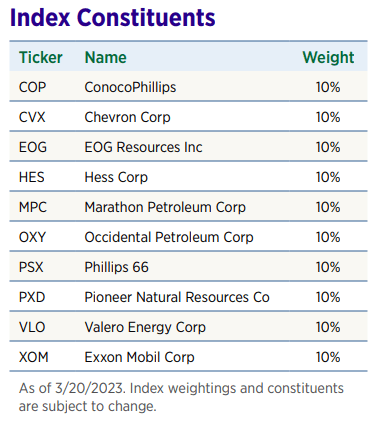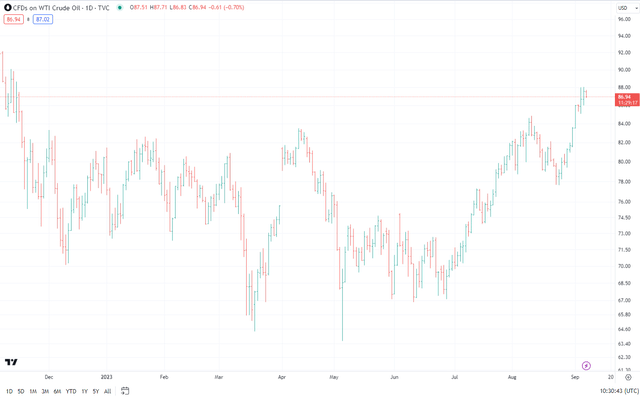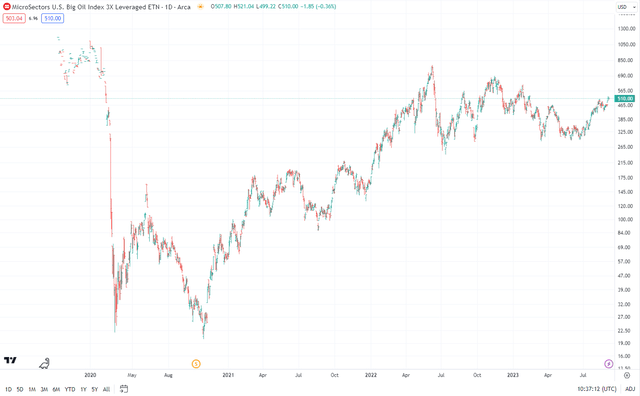NRGU: A Levered Unsecured Oil Play At The Exact Wrong Time
Summary
- Oil prices are surging, raising the risks of stagflation and inflation.
- The MicroSectors U.S. Big Oil Index 3X Leveraged ETNs is a dangerous investment due to its leveraged structure and credit risk.
- NRGU tracks the Solactive MicroSectors U.S. Big Oil Index, which provides a balanced representation of the energy sector.
- Looking for a helping hand in the market? Members of The Lead-Lag Report get exclusive ideas and guidance to navigate any climate. Learn More »
RealPeopleGroup
Truth will rise above falsehood as oil above water. - Miguel de Cervantes
Oil has been on a tear as of late, with many now calling for another surge higher raising the risks of stagflation just as it looked like inflation is finally breaking. I'm more of the opinion this won't happen, but in the event that it does, the question becomes how to play it as a trader. There are a number of solid funds that closely track, from a factor-perspective, the performance of Oil. I'm going to argue here that a levered ETN is not one of them.
The MicroSectors U.S. Big Oil Index 3X Leveraged ETNs (NYSEARCA:NRGU) is an exchange-traded note that provides investors with a unique opportunity to leverage their investments in the big oil industry. It's crucial to understand the mechanics, benefits, and risks associated with investing in leveraged ETNs like NRGU. Spoiler alert - it's a dangerous structure, particularly if a credit event occurs.
Understanding NRGU: An Overview
NRGU seeks to track 3 times the daily performance of the Solactive MicroSectors U.S. Big Oil Index. This index comprises the ten largest and most liquid U.S. stocks in the energy sector. The ETN is designed for sophisticated investors who actively manage their portfolios and are comfortable with daily trading risks. It's important to note that NRGU is not intended for "buy and hold" strategies. The performance of NRGU is reset daily, aligning with its design to achieve its stated investment objectives on a daily basis.
I've talked about this before, but it bares repeating. When you use a daily reset levered vehicle, whether it's an ETF or an ETN, what will drive a significant amount of performance is daily volatility and streaks. If volatility is high in an uptrend, you might gain, but you won't perform that well relative to leverage because successive big up and down says, with leverage, causes decay.
There's more than that though. NRGU is issued by the Bank of Montreal, making it a senior, unsecured debt obligation of the bank. Hence, investing in NRGU inherently involves exposure to the bank's credit risk. This is an underappreciated aspect of ETNs. Because it's unsecured, if a bank runs into trouble, you are actually loaning capital through the Note to an entity that may not be able to pay it back.
Diving Deeper: The Solactive MicroSectors U.S. Big Oil Index
The Solactive MicroSectors U.S. Big Oil Index, which NRGU tracks, is an equally weighted index comprising the ten largest U.S. stocks in the energy sector. This equal-weighting approach provides a balanced representation of the sector, unlike market capitalization-weighted indices, where a few large stocks can dominate the performance. The index was launched in March 2019 and has been providing a unique performance benchmark for the U.S. big oil sector.
The constituents of this index are industry-leading companies, including Exxon Mobil Corporation, Chevron Corporation, EOG Resources Inc., Hess Corp., Marathon Petroleum, Occidental Petroleum Corporation, Phillips 66, Pioneer Natural Resources, Valero Energy Corporation, and ConocoPhillips. Each of these companies has a weight of 10% in the index as of the last rebalancing date.
bmoetns.com
Comparing NRGU with Peers
Comparing NRGU with other similar investment vehicles can provide valuable insights. For instance, the Energy Select Sector SPDR Fund (XLE) is a prominent ETF in the energy sector. However, unlike NRGU, XLE is significantly overweight on Exxon and Chevron. This concentration can impact the performance of XLE, particularly when these companies face challenges. On the other hand, the equal-weighted approach of NRGU ensures a balanced representation of the sector, which can lead to better performance in certain scenarios. That, combined with leverage, can either be a good thing or a bad thing purely dependent upon timing.
Technical Analysis and Performance of NRGU
The performance of NRGU can be influenced by various factors, most notably overall equity volatility, the price of crude oil and the performance of the stocks in the underlying index. For instance, in 2020, NRGU experienced a significant drop in value when the price of crude oil briefly turned negative due to the COVID-19 pandemic's impact. However, as oil prices recovered, NRGU demonstrated a strong comeback, highlighting the potential for high returns in favorable market conditions.
Conclusion: Navigating the Oil Investment Landscape with NRGU
Investing in the oil sector can be rewarding, but it also comes with its share of risks. Leveraged ETNs like NRGU offer a unique opportunity to amplify returns, but they also increase the potential for losses. If we are indeed on the verge of a global credit event, the last thing you want to do is hold onto a leveraged product that is an unsecured debt obligation. If we are indeed on the verge of a global credit event, oil prices can fall sharply.
For me, this is one to avoid here. Yes, it's interesting for tactical traders, but it's a challenging time.
 Anticipate Crashes, Corrections, and Bear Markets
Anticipate Crashes, Corrections, and Bear Markets
Are you tired of being a passive investor and ready to take control of your financial future? Introducing The Lead-Lag Report, an award-winning research tool designed to give you a competitive edge.
The Lead-Lag Report is your daily source for identifying risk triggers, uncovering high yield ideas, and gaining valuable macro observations. Stay ahead of the game with crucial insights into leaders, laggards, and everything in between.
Go from risk-on to risk-off with ease and confidence. Subscribe to The Lead-Lag Report today.
Click here to gain access and try the Lead-Lag Report FREE for 14 days.
This article was written by
Analyst’s Disclosure: I/we have no stock, option or similar derivative position in any of the companies mentioned, and no plans to initiate any such positions within the next 72 hours. I wrote this article myself, and it expresses my own opinions. I am not receiving compensation for it (other than from Seeking Alpha). I have no business relationship with any company whose stock is mentioned in this article.
The Lead-Lag Report is provided by Lead-Lag Publishing, LLC. All opinions and views mentioned in this report constitute our judgments as of the date of writing and are subject to change at any time. Information within this material is not intended to be used as a primary basis for investment decisions and should also not be construed as advice meeting the particular investment needs of any individual investor. Trading signals produced by the Lead-Lag Report are independent of other services provided by Lead-Lag Publishing, LLC or its affiliates, and positioning of accounts under their management may differ. Please remember that investing involves risk, including loss of principal, and past performance may not be indicative of future results. Lead-Lag Publishing, LLC, its members, officers, directors and employees expressly disclaim all liability in respect to actions taken based on any or all of the information on this writing.
Seeking Alpha's Disclosure: Past performance is no guarantee of future results. No recommendation or advice is being given as to whether any investment is suitable for a particular investor. Any views or opinions expressed above may not reflect those of Seeking Alpha as a whole. Seeking Alpha is not a licensed securities dealer, broker or US investment adviser or investment bank. Our analysts are third party authors that include both professional investors and individual investors who may not be licensed or certified by any institute or regulatory body.



